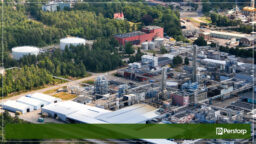First up – what is best-in-class production planning?
People often have different ideas of what constitutes a good production plan – even people within the same organization. For example, a factory manager might favour a plan that maximizes the utilization of a bottleneck resource, while the VP of sales is more likely to focus on delivery performance. While both views are legitimate – you need to consider what is best for the business overall.
By taking a holistic value-based approach, we can define best-in-class production planning as the ability to deliver high-quality plans and schedules that meet demand at minimum cost to the business.
It is vital that all supply chain stakeholders fully understand this value-based approach, as it will impact all planning areas, not just production.
Let’s look at what systems and processes you will need to achieve best-in-class production planning in your organization.
Integrated production planning
Manufacturing doesn’t exist in a vacuum. It’s an integral part of your supply chain, and it’s important that you treat it that way. There’s little point in perfecting a production plan if you’re working to an inaccurate demand plan or have nowhere to store your finished product.
An end-to-end supply chain planning solution synchronizes your production with the rest of your supply chain. As a result, you can stay focused on profitability. An integrated solution also provides an ideal platform for your Sales & Operations Planning (S&OP) process.
Your supply chain will never be stronger than its weakest link. An end-to-end supply chain planning solution synchronizes your production with the rest of your supply chain. As a result, you can stay focused on profitability.
Synchronized planning and scheduling
Master planning and short-term factory scheduling are complementary. The master production plan determines your optimal, typically weekly, production requirements. Detailed schedules then translate your master plan into optimized production sequences for factory floor execution.
If there’s a disconnect between these two levels, your planning will suffer. A system that automatically synchronizes your plans and schedules will help you reach your planning goals and strike the right balance between operational efficiency and delivery performance.
Machine learning & optimization technology
Best-in-class production planning uses Machine Learning and mathematical optimization to optimize your manufacturing in the context of your entire supply chain.
The built-in Machine Learning algorithms analyze your production data, gradually building up knowledge of how different production variables impact your manufacturing capabilities and performance. For example, Machine Learning can help you determine optimal maintenance intervals for your machinery, minimizing unplanned maintenance and expensive downtime.
Companies need planners’ and operators’ experience for manufacturing knowledge. However, the human brain only processes a limited number of variables simultaneously. Machine Learning offers almost unlimited analytical capabilities and can detect operationally significant relationships, often hidden in vast amounts of data. Machine Learning also helps mitigate the contingency problems when experienced individuals leave the company.
The software uses mathematical optimization to create robust plans and schedules that maximize your profits. The optimization algorithms consider your Machine Learning-generated knowledge and all your production rules, costs, and constraints. Traditional planning tools, such as MRP, lack these capabilities and don’t provide enough support for planners.
It’s worth noting that software vendors often use the term “optimization” for marketing purposes. Make sure that your planning solution offers true optimization technology. Otherwise, you will miss out on significant benefits, including the ability to plan for maximum profits.
Production modelling
“If you can’t define the problem, you can’t solve it”. This statement is true for virtually all problem solving, and production planning is no exception.
Luckily, the opposite can also be true. You just need the right software. As long as you can model your production planning problem, optimization algorithms can solve it. By creating a digital representation of your production environment with all your manufacturing rules, costs and constraints, your planning problem can be translated into a mathematical problem and optimized.
It’s essential that you model your manufacturing environment at the level of detail required. For example, while you may only need high-level capacity and labor information for master planning, scheduling will require more granular data. Examples of such data are costs and constraints associated with changeovers, cleanouts and maintenance, and tooling and operator requirements for individual machinery.
The digital model – often referred to as the “digital twin” – should cater to both hard and soft constraints. A constraint may be “hard” in the short term but “soft” in the longer term. For example, we only have one machine that can complete a specific operation at this moment in time (hard constraint). But, looking several months out, we may be able to invest in additional capacity, albeit at a cost (soft constraint). The optimizer will then propose the most profitable course of action.
Speed, simulation and dealing with disruption
Change is constant, and dealing with it is fundamental to business success. Whether it’s an issue on the factory floor or caused by an upstream or downstream process, your production planners and schedulers need to make quick, well-informed decisions to maintain operational efficiency and customer service.
Unlike MRP and spreadsheet tools, optimization is fast. Many companies generate production plans and schedules in seconds rather than minutes. The superior speed allows your planners to re-optimize a plan, either partly or in full, in case of significant adjustments.
The sheer power of optimization engines also means that you can run as many “what-if” scenarios as you want, allowing you to evaluate the impact of your actions before you proceed.
Maximizing planner productivity
A good production planning solution should maximize planner productivity. Your system should offer complete visibility of your production environment and automatically highlight planning exceptions for quick and targeted resolution.
Additionally, planning dashboards help planners and managers stay on top of production performance, while dynamic Gantt charts give schedulers a graphical view of the factory floor.
Importance of data quality and completeness
Building a digital production planning model requires data that is complete and of good quality. Good data is a must for successful planning, and its importance is often underestimated.
However, a company’s biggest mistake is using data as an excuse not to move forward. An up-front data survey and requirements specification will allow you to allocate the right amount of time and resources to this critical task.
Training and redefining the role of the planner
The introduction of optimization will change the role of your planners. Many tasks will become obsolete as the optimizer takes over. Instead, planners can spend more time managing exceptions and making better decisions for the business.
Your planners will need proper training on the new systems to succeed in their redefined role. Planners who can run “what-if” production scenarios and who can alert management to production risks and opportunities will quickly become strategic to the business.
Summary
Manufacturing is an integral part of your supply chain, so it is necessary to take a holistic value-based approach to production planning.
By implementing Machine Learning and optimization technologies, you can synchronize production with the rest of your supply chain and maximize the return on your manufacturing assets.
Do your research and look out for the points discussed in this post. Once you’re up and running with your new solution, you’ll find that the rewards are immediate.
Until recently, optimization software was used almost exclusively by large organizations – mainly due to software complexity and the high cost of in-memory processing of large data volumes. Today, optimization solutions are available through cost-effective, low-risk subscriptions and are much easier to implement, use and maintain.
Get all the latest industry trends, updates & news from Optimity
















